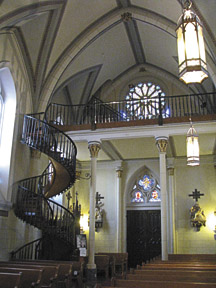CORRECTION: The previous column printed with an unfortunate error; the part of the headline that read “Kentucky and New Mexico” was inaccurate, as it should have read simply, “This land is my land.”
If Hoboken were built with adobe bricks, it might be Santa Fe.
As one of the oldest and most visited cities in New Mexico, sure, Santa Fe may not seem to be Hoboken’s long lost twin upon first glance, but when you scratch the surface, it fits the bill better than any place I’ve hit on the road so far. Something old, classic, and happily small (not to mention expensive) infuses the air the second you ride into town. The atmosphere is familiar and inviting, yet regionally distinct.
The touristy path never feels urban enough to overwhelm with its narrow streets and old (native) world charm, and there seems no need to be anywhere but the historical epicenter of the city (which is also its sophisticated shopping center). The outer edge of this popular area is lined with hotels and motels of all kinds, qualities, and price ranges. Antiquing, jewelry making, fine arts, and sightseeing are the hands that feed Santa Fe’s cultural soul and keep its economic pulse strong.
Spanish pueblo-style buildings line the historic plaza area with small-scale architecture while parking meters line the street in front of boutiques and restaurants, and excessive overflow pours into parking garages off the main streets. There’s a variety of fine Native American crafts and various upscale galleries within walking distance of the central square with a monolith the shape of the Washington Monument but about a 10th of the size.
Not far from the plaza, the Cathedral Basilica of St. Francis of Assisi is massive and elaborate, but most attention falls to a tiny church a couple blocks away called Loretto Chapel. In the late 1800s, a mystery carpenter built what has come to be known as the Miracle Staircase. The legend goes that the master carpenter spent six months creating a modern marvel of woodwork with rudimentary tools.
The truth is debated to this day, as many candidates and much evidence has been cited to strip the stairs of their miraculous origins. But the facts and masterful craftsmanship are undeniable; the winding staircase has stood floor to choir balcony without a supporting center column for more than 130 years. Seeing it will cost $2, but it’s an impressive, beautiful, and awe-inspiring sight, and this feat of design and carpentry dates back to the advent of this southwestern Mecca.
Lying at the end of the Old Santa Fe Trail and the pioneering Atchison, Topeka & Santa Fe Railroad, the capitol of New Mexico grew quickly. But even today, it’s fairly small in size for a city of such importance, hosting an estimated 72,000 residents. Santa Fe has a rich western history, enjoying its status as a popular destination since its founding about 400 years ago. The city served as a gateway to the southwest frontier in the second half of the 19th century. As an extra incentive, the lifestyle there in that era was closer to that of civilized society than wilder neighbors such as Las Vegas (New Mexico, that is).
In 1878, more than 30 years after New Mexico became a U.S. territory, a famous Civil War general by the name of Lew Wallace came in to clean up the soon-to-be state and tame the wildest land in the era of the Wild West – obviously, a difficult and frustrating challenge. Especially since Wallace took up his political appointment right when Billy the Kid became the biggest threat to keeping the peace. Today, the hard-nosed governor is best known for writing the literary (and screen) classic Ben-Hur, published in 1880.
Walking the streets in Santa Fe’s historic district, it’s easy to imagine the history that lies just beneath the asphalt in the dry desert dirt. Though the second you pass someone with bags upon bags of handmade souvenirs from an extravagant shopping spree, you’ll snap right back to the present.
Stores like the Wild River Trading Co. sell handmade silver and turquoise jewelry as well as western wear, including leather hats, jackets, and boots. Most shops carry everything from handmade water basins and rugs to decorative Native American dreamcatchers and knives. Santa Fe shoppers can find an array of southwestern paraphernalia ranging from the relatively cheap to the astronomically overpriced.
Before departing New Mexico’s cultural capital, I ate at the French Pastry Shop & Creperie, which might seem like an odd choice, but the place was packed. Locals and visitors alike flock there for the authentic French taste as well as the freshly prepared breakfast sandwiches and treats. The crepe sucre was exactly what you would get in any Parisian bakery worth its batter. And yet the interior is pure and quaint southwestern comfort.
Santa Fe was once the heartbeat of the Old West. Today, it’s the heartbeat of the southwest.
Next stop: taking a right turn at Albuquerque and onto the Main Street of America.
